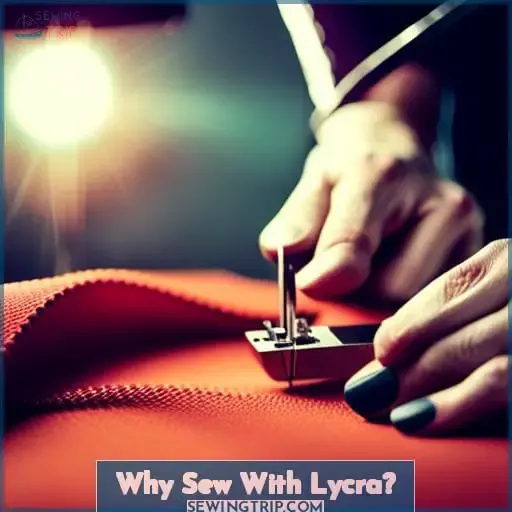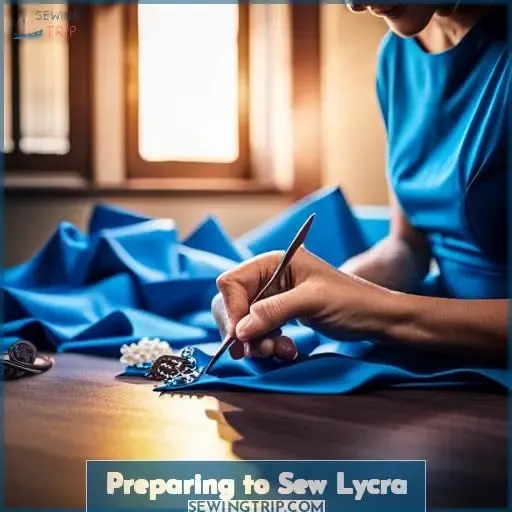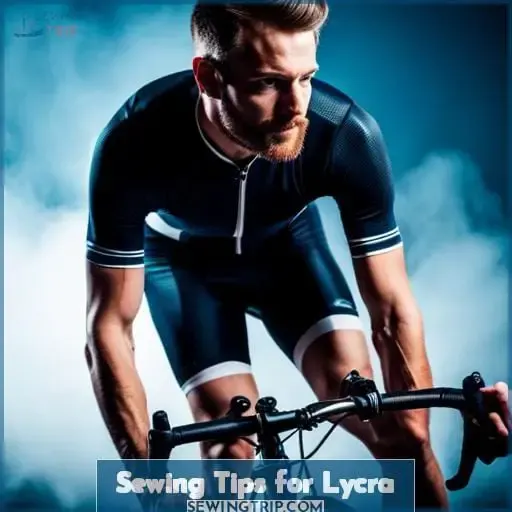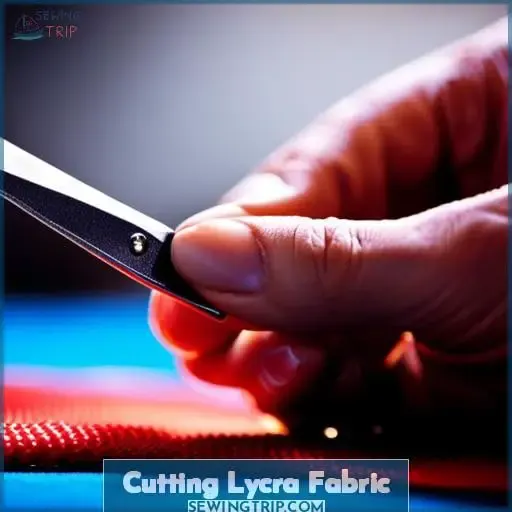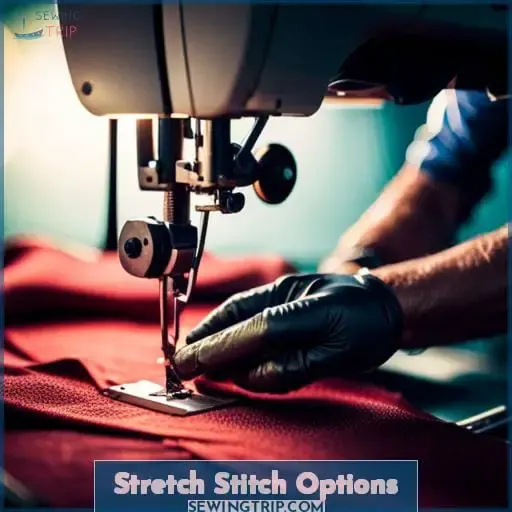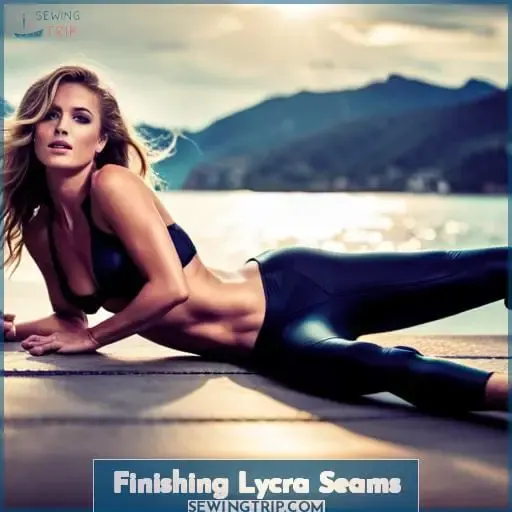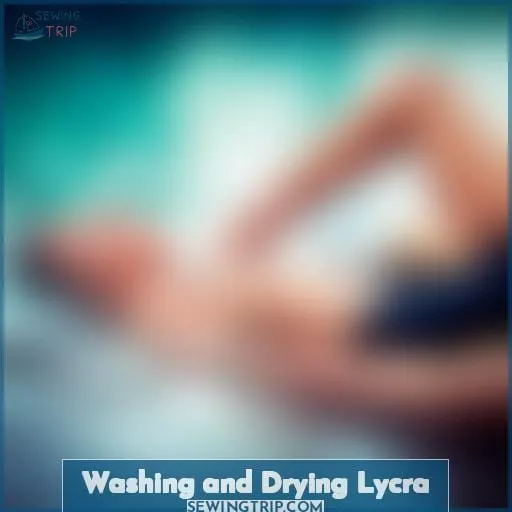This site is supported by our readers. We may earn a commission, at no cost to you, if you purchase through links.
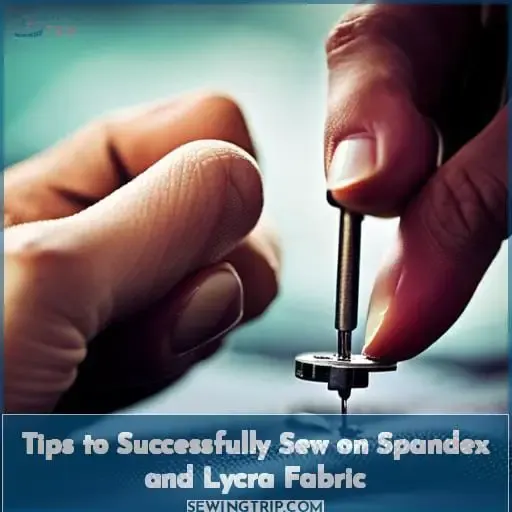
First, use the correct needle and thread to avoid snags. Adjust your machine’s tension and stitch length for smooth sewing.
Proper cutting, pressing, and finishing will also help you achieve professional results.
Most importantly, take your time, go slowly, and don’t pull or stretch the fabric as you sew.
Follow these tips and you’ll create successful lycra and spandex projects.
Table Of Contents
Key Takeaways
- Select specialty needles and threads like stretch needles and polyester thread
- Use tools like wonder clips instead of pins and adjust machine foot pressure
- Consider specialized stitches and machines like coverstitch and sergers
- Carefully handle lycra with lower temperature washing, air drying, and proper storage
What is Lycra?
Lycra is the brand name for a stretchy, synthetic fabric that contains the elastic fiber spandex.
This innovative fabric is known for its exceptional elasticity that allows it to stretch up to seven times its original length without breaking.
Lycra’s ability to snap back to shape makes it an ideal choice for form-fitting fashion pieces and athleisure wear.
Sewing with Lycra does come with some challenges due to its ultra-stretchy and smooth texture that can be slippery and tricky to work with.
However, the versatility and comfort that finished Lycra garments provide make it a rewarding fabric for fashion designers, crafters, and DIYers to sew.
By following specialized techniques like using sharp stretch needles, polyester thread, and wonder clips instead of pins, sewers can create beautiful, custom-fitted lycra projects from scratch.
Mastering lycra sewing unlocks exciting possibilities for fashionable, stretchy creations.
Why Sew With Lycra?
Many crafters love sewing with Lycra for its incredible stretch and ability to hug the body, allowing them to create form-fitting garments and accessories that move with you.
Create flattering exercise attire that moves with your body.
Craft comfortable pajamas and lounge wear with custom prints.
Design DIY yoga pants that perfectly fit your shape.
Make scrunchies and headbands that stay put while working out.
Sewing with stretchy Lycra spandex gives crafters the flexibility to create personalized activewear, shapewear, swimsuits and more that feel like a second skin. The fabric’s lightweight stretch is perfect for following body contours. Crafters can design custom prints for their stretchy creations using Spoonflower or other services.
With some skill and Lycra yardage, sewists can craft beautiful garments and accessories that offer exceptional comfort.
Preparing to Sew Lycra
Before beginning any Lycra sewing project, you must select the proper needles, threads, clips, and machine settings.
Adjust your sewing machine to a lighter foot pressure.
Swap out regular needles for stretch ones.
Thread up with strong polyester.
Also, consider employing wonder clips instead of pins to avoid damaging the delicate fabric.
Needles for Lycra
To ensure successful sewing with Lycra:
- Carefully choose the right needles.
- Opt for stretch needles with a special coating to reduce friction and prevent skipped stitches when sewing on the smooth, delicate fabric.
- Use polyester thread for strength, colorfastness, and compatibility.
- Wonder Clips gently secure the fabric instead of pins that can damage it.
- Adjust your machine’s foot pressure down.
- Consider a walking foot for stability across the slippery layers.
Thread for Lycra
You’ll want to use polyester thread when sewing with Lycra.
Polyester thread offers stretchy strength, flexibility, and sewing machine compatibility.
Opt for colorfast polyester threads in tones matching or blending with your Lycra fabrics.
Wonder clip wisdom lets you avoid pin damage.
Adjust to a lighter foot pressure for smoother gliding across Lycra’s slippery surface.
Seamless serger and coverstitch machine options can save frustration when dealing with this stretchy fabric.
Clips Vs Pins
Rather than pinning the lycra, you’d do better to use clips so you don’t damage the delicate fabric.
Wonder clips grip the fabric firmly without putting holes in it like pins would. They also won’t get caught by the walking foot or leave rust marks.
For best results, use the clips perpendicular to the seam allowance. This allows the feed dogs and presser foot to move the layers smoothly.
Adjust Sewing Machine Pressure
When sewing spandex or lycra, adjust your sewing machine’s foot pressure to a lighter setting for a smoother glide across the fabric.
This allows the foot to glide smoothly over the fabric without catching or stretching it out. Proper pressure adjustment creates smooth seams on delicate fabrics like lycra and spandex.
Set the tension between 2-3 to prevent skipped stitches.
Use a straight stitch throat plate for more precision stitches.
Test on scrap fabric first before sewing your project.
Use a Walking Foot
You’d better put a walking foot on your machine when working with lycra.
It’ll help feed the layers smoothly without letting them stretch out unevenly.
A walking foot provides stability when stitching, controlling how the fabric feeds under the needle for precision and even movement.
This prevents the material from distorting as you sew.
Investing in a serger or coverstitch only machine are other great options for sewing on dance fabric, swimsuit patterns, and unitard patterns.
Best Machines for Sewing Lycra
When working with delicate, stretchy fabrics like spandex and lycra, specialized machines can make all the difference.
Opt for a serger to professionally finish edges.
Opt for a coverstitch machine to recreate the topstitching seen on activewear.
Opt for a twin needle for faux coverstitching along a hem.
Investing in one of these machines saves frustration and takes your stretch fabric projects to the next level.
Sergers
You’ll find sergers optimal for constructing professional, stretchy seams on lycra.
With specialty knives and loopers, sergers trim fabric edges while encasing them in thread using an overlock stitch.
Sergers also allow effective elastic gathering by adjusting differential feed.
Investing in a serger pays dividends when frequently sewing stretch fabrics like spandex and lycra.
However, by creatively using tools like a zig-zag stitch and straight stitch throat plate, home sewists can still achieve quality results.
Coverstitch Machines
How else can you achieve the professional double row of stitches seen on athletic garments when sewing lycra if not with a coverstitch machine?
- Focus on finishing fabric edges perfectly.
- Experiment with creative coverstitch techniques.
- Learn the differences between sergers and coverstitch machines.
- Make your own activewear with custom printed designs.
- Explore options for seam finishing with a coverstitch machine.
Twin Needles
You’d use a twin needle in place of a coverstitch machine to add two lines of stitching on the hem of your stretch fabric projects.
Explore creative stitching patterns with a twin needle on lycra fabric to make embellishments or elastic gathers.
Choose a stitch length allowing optimal fabric recovery.
Adjust tension so the twin needle produces even stitching without puckering the fabric’s surface.
Master twin needle techniques to professionally finish stretch projects without a coverstitch machine.
Sewing Tips for Lycra
Use a longer stitch length than normal, around 3mm, to make any necessary seam ripping easier.
Consider installing a straight stitch throat plate, which prevents the fabric from getting sucked down into the bobbin area on your regular sewing machine.
Following these simple suggestions will help you achieve smooth sewing and avoid headaches when working with tricky lycra.
Stitch Length
Fabric Handling
Needle Choices
Stitch Techniques
Seam Finishing
Throat Plate
You’ll need a straight stitch throat plate to prevent the delicate lycra fabric from diving into the bobbin area of your sewing machine.
The narrow opening and smooth surface of a throat plate made for straight stitch precision ensures the fabric feeds through properly.
Without one, lycra’s slippery nature could cause skipped stitches or bunching.
Check your machine’s manual on changing out standard throat plates for specialty ones, allowing you to harness lycra’s stretchiness without frustration.
Cutting Lycra Fabric
Once you have prepared your sewing machine and gathered your supplies, you’ll need to take care when cutting your Lycra fabric.
Here are 4 tips for precision cutting:
- Let the fabric rest before cutting to allow the fibers to relax.
- Use extremely sharp scissors designed for cutting delicate fabrics.
- Avoid using pins when cutting Lycra as they can damage the knit. Use weights instead.
- Only cut one pattern piece at a time to prevent distortion or misshaping.
Taking care during the cutting process will help ensure your pieces retain their shape and provide the proper stretch and recovery needed for your project.
Sharp tools, proper layout, and handling the fabric as little as possible will lead to success.
Stretch Stitch Options
When sewing with spandex and lycra fabrics, choosing the right stretch stitch is crucial.
After cutting your fabric pieces, move your focus to your sewing machine settings.
Use a zigzag or multi-stitch zigzag, which allow the stitches to stretch with the fabric.
You can also use your machine’s built-in stretch stitches, like the lightning or triple straight stitch. These stitches are designed to provide the right amount of give when sewn on stretchy fabrics.
For maximum stretch and elasticity, try elastic gathering by increasing your machine’s stitch length to 5mm or longer.
Remember to account for fabric recovery and provide enough stretch factor in the seam.
Consider investing in a serger if you frequently sew spandex – the overlocking stitch gives knit seams more stretch than a basic zigzag from a regular machine.
Finishing Lycra Seams
After stretch stitching Lycra seams, you’ll want to finish them properly so they don’t fray or come undone.
For seam finishes, consider:
- A serger or overlock stitch to enclose the raw edges in thread.
- Double-stitching close to the seam’s edge.
- A row of zigzag for extra reinforcement.
When hemming Lycra, utilize variations like:
- Twin needle stitching.
- Coverstitching for stretch and durability.
Reinforce edges with bias tape folded over the raw seams.
Experiment with different stitching techniques when finishing seams, like:
- Increasing stitch length.
- Using contrasting thread colors for interesting visible seam finishes on Lycra.
Choose options providing neat enclosed edges, strength, and elasticity – essential qualities for long-lasting seams on activewear and lingerie made with delicate fabrics like Lycra.
Washing and Drying Lycra
Carefully wash and air dry your finished Lycra projects to prevent damage and maintain the fabric’s elasticity.
When it’s time to clean your Lycra creations, use a gentle hand wash or delicate cycle in cold water to prevent heat damage.
Avoid using hot water or steam when washing, as this can compromise the stretch and structure of the Lycra fibers.
Skip the dryer and allow your projects to air dry fully, laying them flat or hanging to dry.
The heat and tumbling of a dryer, even on low, can distort the shape and cause Lycra items to shrink.
With proper cold water washing and air drying, you’ll keep your Lycra stretchy, smooth, and ready to comfortably hug your body through many wears.
Handle with care and your handmade Lycra gear will retain its shape and elasticity for the long run.
Creative Uses for Lycra
One can explore many creative possibilities with lycra fabric.
Functional fashion awaits the innovative mind.
Create athletic expressions like original yoga wear.
Craft home goods that display lycra artistry, like lampshades and cushions with custom prints.
Accessorize with elastic belts, headbands, and scrunchies in an array of textures.
Give free rein to imagination when working with this versatile medium.
Lycra lends itself well to functional fashion that flatters.
Blend it with other fibers for unique fabrics.
Home décor can turn playful and stretchy.
Lycra’s elasticity enables athletic expressions and freedom of movement.
Tap into its creative potential to birth inspired designs that bring your artistic vision to life.
Frequently Asked Questions (FAQs)
What needles work best for sewing lycra fabric?
Use stretch or ballpoint needles specifically designed for knit fabrics when sewing lycra.
These needles have a special coating to allow them to glide smoothly without damaging the fabric’s delicate fibers.
Select the appropriate size needle for your thread and fabric weight too.
Should I use a walking foot when sewing lycra?
Yes, using a walking foot is an absolute must when sewing lycra.
The walking foot feeds the top and bottom layers of fabric evenly, preventing the stretchy lycra from shifting around.
This helps ensure straight seams and prevents skipped stitches or puckering.
Simply attach your machine’s walking foot and sew as usual with a stretch needle and polyester thread for best results.
How much stretch should I allow for when cutting lycra fabric?
When cutting lycra fabric, allow 10-20% extra fabric than the finished measurements.
This additional stretch allowance prevents the fabric from being overstretched and distorted during sewing.
Handle the slippery fabric gently.
Measure accurately and cut precisely to achieve the best fit for your project.
What thread is best to use when constructing seams in lycra garments?
Use 100% polyester thread when constructing seams in lycra garments.
Polyester thread offers strength, flexibility, and durability to withstand the stretch and movement of lycra fabrics.
Make sure to use a stretch or ballpoint needle.
Adjust your machine’s settings for stretch fabrics as well.
Are there any special pressing techniques I should use when working with lycra fabric?
When pressing lycra fabric:
- Use a press cloth to protect the fabric.
- Set your iron to a low heat setting.
- Avoid using steam, which can damage stretch fabrics.
- Gently lift and lower the iron, rather than pushing it across the fabric to prevent distortion.
Allowing the lycra to cool completely before moving it will help retain the shape.
Conclusion
Sewing with lycra can feel daunting, but taking it slow and preparing correctly will lead to success.
Invest in quality needles, thread, and machines.
Adjust settings and use appropriate stitches.
With some patience and the right tools, you’ll be able to expertly handle how to sew lycra for any project.


